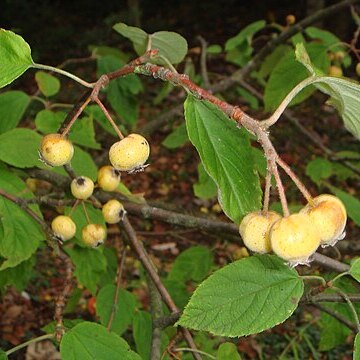Trees to 10 m tall. Branchlets dark purple or purplish brown when old, terete, robust, tomentose when young, glabrous when old; buds dark purple, ovoid, glabrous or scales sparsely puberulous at margin. Stipules caducous, linear, 6–8 mm, membranous, white tomentose adaxially, margin sparsely glandular denticulate, apex acute; petiole 2–3.5 cm, tomentose; leaf blade ovate, broadly ovate, or narrowly elliptic-ovate, 6–12 × 4–7 cm, abaxially tomentose or subglabrous, adaxially subglabrous, base rounded or cordate, margin doubly serrate, each side 3–5-lobed, apex acute. Corymb umbel-like, 5–9 cm in diam. 8–12-flowered; bracts caducous, linear-lanceolate, membranous, adaxially tomentose, margin sparsely glandular denticulate, apex acuminate. Pedicel 1.5–3 cm, tomentose. Flowers ca. 1.5 cm in diam. Hypanthium campanulate, abaxially tomentose. Sepals triangular-ovate, 3–4 mm, ca. as long as hypanthium, both surfaces tomentose, margin entire, apex acuminate. Petals white, suborbicular, ca. 8 mm, base shortly clawed, apex rounded. Stamens 20–25, unequal, slightly shorter than petals. Ovary 5-loculed, with 2 ovules per locule; styles 5, nearly as long as stamens, glabrous basally. Pome red, globose, 1–1.5 cm in diam., white punctate; fruiting pedicel 2–3 cm; sepals persistent. Fl. May, fr. Aug–Sep. 2n = 34*.
More
A deciduous tree. It grows 10 m tall. It is a broad column shape. The bark is dark grey-brown. It peels in small flakes. It is orange-brown when freshly exposed. The leaves are broadly oval and 10 cm long by 9 cm wide. They are heart shaped at the base. They are pointed at the tip and have shallow lobes. There are fine teeth. They are matt pale green above and softly hairy underneath. They turn orange to red and purple in autumn. The flowers are 1.2 cm across and are borne in flattened heads. The fruit are rounded and hard. They are 1.5 cm across and deep red colour. They occur in dense clusters.
Can be grown by cuttings or seedlings. Seeds needs stratification.

